
Thinkstock Images / Getty Images
This time last year interest in virtual reality (VR) was largely confined to experiential installations and the games industry. However, if you entered 2016 with little or no knowledge of VR or augmented reality (AR), an overnight phenomenon back in July is likely to have changed that. Nintendo's Pokemon Go brought AR to a vast global audience by making it common place through everyday smartphones. The international craze around this game showed both consumers and brands that this market is not only exciting and accessible, but also worth investing in. Deloitte Global predicts that half a million 'mobile VR' headsets (such as Samsung Gear) will be sold in 2016. The use of smartphones within VR hardware means that it's getting cheaper to view and will eventually be cheaper to deliver, opening up the immersive experience to the masses.
Arguably VR is the biggest development in image making since photography went digital. For the team here at Getty Images, this is hugely exciting as we enter a new age of image creation. At the Olympic Games in Rio earlier this year, all of our photographers were kitted with 360° cameras. This allowed them to capture images that not only documented what was happening, but would allow the viewer more access than ever before, to a place they would otherwise never see.
Technology has extended the human experience past the limits of biology and physiology. VR gives the viewer an immersive experience; it lets you be in the place rather than a passive viewer looking through a 2D window. In today's world of hyper-connectivity, our sense of space and our desire for meaningful experiences has undergone a revolution. We crave immersive experiences because they are highly emotive and this technology is not only allowing brands and gamers to create more 'real' experiences, but welcoming a new world of storytelling between people. For those brands looking to excite consumers in a new way, VR may hold the key. As this technology becomes more accessible in the everyday, those brands who have experimented with VR already will create a stronger founding for the future.
As the year draws to close, here are three brands that I believe have used VR the most effectively and imaginatively in 2016:
1. Dreams of Dalí
Salvador Dalí imagined surreal landscapes filled with melting watches and lobster telephones. His paintings worked as a window into these bizarre worlds. However, thanks to a partnership between Disney and the Dalí Museum you can now virtually enter the mind and works of the artist. The immersive experience takes the user into his 1935 painting Archeological Reminiscence of Millet's "Angelus". Viewers are free to explore the haunting terrain coming face to face with Dalí's characters.
Watch: Dreams of Dalí: 360º Video
2. Largest coral reef
Who doesn't dream of joining Attenborough on his epic adventures when watching Planet Earth? Well, thanks to a VR collaboration with the Natural History Museum, you now can. This Atlantic Productions VR experience combines the Museum's world-leading research with amazing 3D technology, vividly presenting the reef's colourful corals and darting shoals of tropical fish.
With Sir David Attenborough guiding the way, it is a fantastic way for the Natural History Museum to bring VR to children and adults too.
3. New York Times - New York Times VR
This app is fantastic. The use of VR and 360° imagery takes the viewer from passively watching the action unfold, to experiencing the joy and pain these journalists are reporting first hand. To date the platform has taken viewers inside the war-torn homes of Syria, struggling police departments in the US and to laughter yoga retreats in Asia. New York Times has tapped into VR and used it to explore reportage imagery in an unparalleled form, not only delivering the stories of the world to people but drawing them into it.
How it works: NYTVR
VR is working through its difficult adolescence years, finding its place in the world. It is clear to see that this technology has all the potential to revolutionise the way we consume visuals, much like colour film did in the 1930s. Brands should be considering how to use VR, especially in easily accessible and affordable formats like Google Cardboard as they are adopted more widely. We're entering a new and exciting time for visual language and I can't wait to see what comes next.
